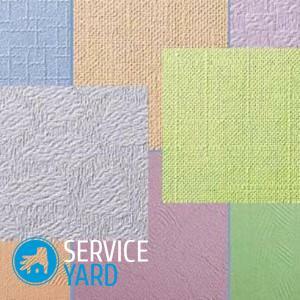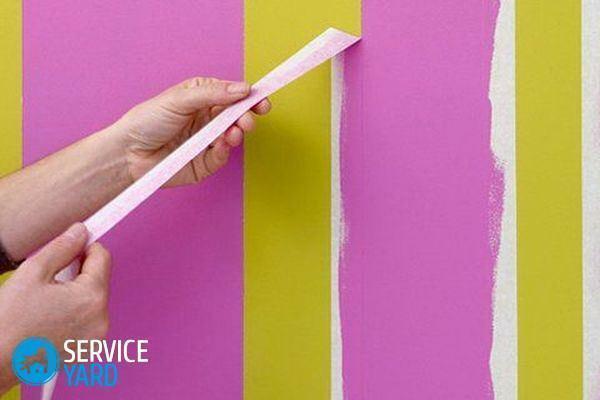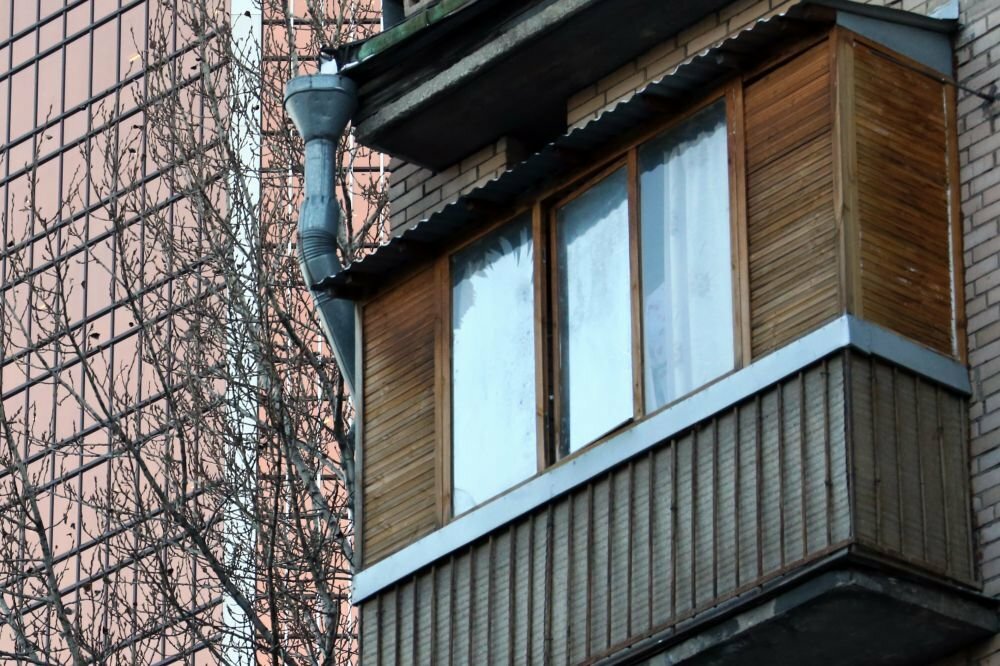
- What are the colors?
- How are they different?
- What color?
- Basis and Colors
- How to choose paint for wallpaper for painting?
- Calculating the amount of paint
- Beginning to paint
- Some useful tips for
The times when the apartments looked alike, like twins, are a thing of the past. Manufacturers of products for repair offer buyers such assortment of wallpapers, paints, varnishes and everything else that almost everyone has the opportunity to create a unique interior. And more and more popular is getting wallpaper that you can paint. But there is always a question, and what should be the paint for the wallpaper for painting? This is described in the article.
to the contents ↑What are the colors?
Decorating an apartment with wallpaper that can be painted has great advantages:
- you do not need to customize the drawing;
- wallpaper can be painted more than once;
- if the color or drawing gets tired - you can again change the design in two counts.
In the shops you can find two types of paints for wallpaper:
- water-emulsion;
- water-dispersive( latex).
Important! They have much in common. Neither water-based, nor water-dispersion paints do not emit harmful substances, that is, they are safe. Neither one nor the other does not have a characteristic smell of paint. In addition, they are very easy to work with, so even an inexperienced painter will cope with this task.
to the contents ↑How are they different?
The main difference between water-based and water-based paints is their relation to water:
- Water-based paints dissolve in water, therefore it is not necessary to use them in rooms with high humidity.
- Water-dispersion paints are not washed off, so you can get wallpaper, which are actually washable, as a result of repair.
Water dispersion paints
They, in turn, are divided into two types:
- based on PVA;
- based on acrylic resins.
Important! In fact, all the colors of this species are quite resistant to moisture. But, if PVA-based paints can withstand, for example, a small one-time leakage of the pipe, then frequent washing of walls can be fatal. The walls, painted with acrylic paints, can be washed quite calmly, there will be no irreparable consequences.
Water-dispersion paints have another undoubted advantage - they practically do not burn out.
Kinds of surfaces
Both water-based and water-dispersion paints allow to obtain several types of surfaces:
- glossy;
- matte;
- half-matched.
Important! The surface appearance is usually indicated on the package. How to choose a paint for wallpaper for painting - it's up to you:
- The matte surface is more suitable for a bedroom and a nursery, because it does not irritate the eye, and small random contaminants are seen less on it.
- For the living room and glossy walls, let alone the kitchen, where everything should shine.
How to paint?
Before you go to the store where the paint for wallpaper is sold, decide what else you need, because you can buy everything in one department. You, at a minimum, will need something else, which you will paint, that is:
- roller;
- brush;
- nebulizer.
Important! An unequivocal answer to the question, what is more convenient to apply the paint on the wallpaper, does not exist, because these paints fit perfectly in any case. It's a matter of personal convenience for every domestic craftsman.
But if the wallpaper with a pronounced relief, they need to be painted necessarily with a roller, and it is good to roll every detail.
to the contents ↑Basis and colors
Once in the store, you are likely to be slightly puzzled - it turns out that the color spectrum of water-based and water-dispersion paints is very limited. If you can find a colored water-based paint with great difficulty, then latex paints are on sale only white. Nothing wrong with that.
How to get the color?
The paint of the desired shade is obtained by tinting, that is, adding white pigment to the pigment. But there are a lot of pigments.
So how is the paint for the wallpaper painted painted? There are two options;
- manual;
- computer.
Manual mixing
In the first case everything is extremely simple:
- Bring home the paint.
- You pour it into the bucket.
- You fall asleep a pigment.
- Thoroughly mix.
Important! This, of course, is a popular method, especially where there are no solid construction stores nearby. But this method has several significant drawbacks:
- The paint must be mixed very carefully, otherwise - the color can turn out uneven.
- If you do not have enough paint, it will be very difficult to prepare a new portion so that it does not differ in color.
- The color of the walls after drying may not be exactly what you wanted.
Computer technology
Computer tinting, of course, is preferable. Moreover, it is often provided as an additional service for which the buyer does not pay anything:
- You come to the store and choose the desired color from the catalog.
- Tell the consultant how much solution you need.
- With the help of computer calculations, the consultant loads a special machine - the output is a mixture of the color you need.
Important! This method has a lot of advantages, but the most important thing is that if you suddenly need a second dose of paint, you will just come to the same store with a check on which the code is written. According to him, the consultant will make the next portion - and the decor will not be different from the one that you have already laid on your walls.
to the contents ↑How to choose a paint for wallpaper under painting?
Have you decided what color walls will be in your apartment? Now it's time to decide which type of solution is right for your wallpaper. To do this you need to know a little about the wallpaper itself, for the good of the store you will find their great variety.
For wallpapering suitable wallpaper:
- paper;
- vinyl;
- non-woven;
- fiberglass wallpaper.
 How to understand?- There are no complications here:
How to understand?- There are no complications here:
- For paper wallpapers, any paint is suitable. On them equally well lies both water-emulsion and acrylic.
- For vinyl wallpaper, water-based emulsion will not work. She just will not lie on such a surface. For this type of wallpaper is suitable only acrylic solution on a latex base.
- But if your vinyl wallpaper is not on a non-woven base, any mixture is suitable for them.
- For non-woven wallpaper, the paint must be water-based. By the way, these wallpapers have a very interesting property - they can be tinted from two sides. For example, if the wallpaper is already pasted, you can paint the outside, and it will be beautiful. But no less impressive, when the side is painted that is adjacent to the wall. Of course, it is applied before gluing. The result is usually very impressive: a beautiful smooth background appears on which a beautiful texture appears.
- Any glass is suitable for glass walls, but liquid wallpaper does not paint at all. In this case, the wall is painted, and then liquid wallpaper is poured onto it.
Calculating the amount of paint
Perhaps the most difficult moment is calculating the amount of paint for the wallpaper for painting. It all depends on how many layers of paint you are going to apply, as well as how well the surface absorbs decorative solutions.
Important! The standard calculation for one layer is 250 g of paint per 1 square meter. If the wallpaper is poorly absorbed by the paint, it usually takes about 1 liter to 10 square meters. For an absorbent surface, a decorative mixture is required that is one and a half times larger.
If you want to make an extremely accurate calculation, then proceed as follows:
- Calculate the total area of the walls.
- Subtract the area of all window and door openings from it.
- Calculate the amount of the mixture, based on the type of surface and the number of layers.
- Buy a solution of interest on twenty more than it turns out by calculations.
Beginning to paint
In order to start the repair, you need:
- paint for wallpaper for painting;
- brush or roller;
- adhesive tape( paint);
- portioning tray;
- construction rod.
Before you start the repair work, look at the old wallpaper, unless you are going to transform it. In any case, the surface must be leveled. After this, proceed to painting:
- Stick adhesive tape where the wall is connected with skirting boards, ceiling, window and door apertures.
- Type the ink in the tray.
- Roll it out or smudge it with a brush.
- Remove the excess mixture from the tray.
- Attach the roller to the rod.
- From the top down, roll the solution over the entire wall.
- Paint the corners and areas adjacent to the ceiling and skirting boards - this is done with a brush, even if the rest of the work was done by a roller.
Important! If there is a different color on the wall, it is applied after the wall has dried.
to content ↑Some useful tips for
Walls in a room do not have to be decorated in one color. Combinations are not just permissible, they can look very impressive, In addition, different shades can be used for zoning - this is especially true for the owners of small apartments. And for repair to give you pleasure, consider a few simple tips:
- To work with any paint you need work clothes and a hat.
- Furniture is better to take out, and one that can not be removed - covered with plastic wrap, for example, the one that the greenhouses are closing - you can buy it in the stores for gardeners.
- You in any case need a stepladder - it should be stable.
We hope that you were able to determine what paint for the wallpaper for painting better suited for your interior and were able to with utmost precision to embody your fancy decor. Hence - you will always be pleasant and comfortable in your home.

